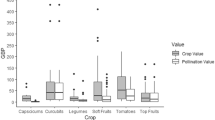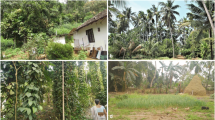Abstract
This paper deals with the coexistence of agricultural models from the perspective of land management on the urban fringe. Our goal is to show how urban local authorities deal with and influence the coexistence of models when they are involved in farmland management, and more specifically when they determine which farmer should be allocated what land and under which lease agreement. To do this, we compare public processes of farmland allocation led by French local authorities on the urban fringes of Lyon, Montpellier, and Perpignan. This geographic study is based on qualitative methods (observations, interviews, and document analysis). The comparison of seven case studies illustrates the changing balances of power on urban fringes between agricultural models and between urban and agricultural stakeholders. As urban local authorities grant them land and legitimacy, farmers willing to develop agroecology and short food supply chains may settle in peri-urban areas, where access to land is otherwise very difficult for outsiders. Some public allocations of farmland divide space between models following agronomic and esthetic criteria, but few public bodies venture to hierarchize models by an unequal repartition of land property rights. Beyond their limited spatial impact, public allocations of farmland are actually important local initiatives for the institutional recognition of sustainable agriculture models, one driver within urban policies aiming at supporting a transition towards agroecology and more sustainable food systems. Governance processes could, however, be improved if local authorities would more explicitly tackle the possible issues related to the coexistence of diverse agricultural models in space, as in public debates and policies.

Similar content being viewed by others
Notes
[Land use and rural settlement corporation]: a semi-public body which controls land ownership: it holds a preemptive right on all farmland put on the market. When it was created in 1962, its goal was to support the increase in farm size while avoiding land grabs. More details may be found in Sencébé et al. (2013).
In France, land lease agreement prices are regulated by the State.
Mutualité sociale agricole; in French, the social security system of the agricultural sector.
References
Altieri, M., & Nicholls, C.I. (2012). Agroecology scaling up for food sovereignty and resiliency. In E. Lichtfouse (ed.), Sustain. Agric. Rev., 11. Springer, Netherlands, 1–29.
Barral, S., & Pinaud, S. (2015). Les agriculteurs, maîtres tenaces de l'accès à la terre. Les impasses de la politique foncière française contemporaine. Mouvements, (84), 64–72.
Barral, S., Pinaud, S. (2017) Accès à la terre et reproduction de la profession agricole. Revue Française de Socio-Economie, 18, 77–99.
Baysse-Lainé, A. (2018). Terres nourricières? La gestion de l’accès au foncier agricole en france face aux demandes de relocalisation alimentaire. enquêtes dans l’amiénois, le lyonnais et le sud-est de l’aveyron, Phd thesis, Université Lumière Lyon 2.
Baysse-Lainé, A., & Perrin, C. (2018). How can alternative farmland management styles favour local food supply? A case study in the larzac (france). Land Use Policy, 75, 746–756. https://doi.org/10.1016/j.landusepol.2018.03.012.
Baysse-Lainé, A., Perrin, C., Delfosse, C., 2018. Le nouvel intérêt des villes intermédiaires pour les terres agricoles: actions foncières et relocalisation alimentaire. Géocarrefour, 92. https://doi.org/10.4000/geocarrefour.10417.
Beckett, J., & Galt, R. E. (2016). Land trusts and beginning farmers' access to land: exploring the relationships in coastal california. Journal of Agriculture, Food Systems, and Community Development, 4(2), 19–35.
Bertrand, N. (2013). Terres agricoles périurbaines: une gouvernance foncière en construction. éd. quae, versailles, france.
Blay-Palmer, A., Sonnino, R., & Custot, J. (2016). A food politics of the possible? Growing sustainable food systems through networks of knowledge. Agriculture and Human Values, 33, 27–43. https://doi.org/10.1007/s10460-015-9592-0.
Coolsaet, B. (2016). Towards an agroecology of knowledges: recognition, cognitive justice and farmers’ autonomy in France. Journal of Rural Studies, (47), 165–171.
Daurelle, A., Richard, S., Rihouet, F., Quesnel, R, & Et de boyer D’eguiles, C. (2015). Foncier: entre avenir et héritages, scoping report, Jeunes Agriculteurs, Le Mans (France).
Depraz, S. (2008). Géographie des espaces naturels protégés: genèse, principes et enjeux territoriaux. Paris: Armand Colin.
Hasnaoui Amri, N. (2018). La participation des agriculteurs à une politique alimentaire territoriale. le cas de montpellier méditerranée métropole. phd thesis, Université Paul Valéry Montpellier 3.
Hobeika, A. (2013). La collégialité à l’épreuve. La production de l’unité au sein de la FNSEA. Politix, 103(3), 53–76.
Horst, M., & Gwin, L. (2018). Land access for direct market food farmers in Oregon, USA. Land Use Policy, 75, 594–611.
Ilbery, B., Ingram, J., Kirwan, J., Maye, D., & Prince, N. (2012) Non-successional entry into uk farming: an examination of two government-supported schemes. In M. Lobley, J. Baker and I Whitehead, I. (dir.), Keeping it in the family. International perspectives on succession and retirement on family farms, Routledge, Oxford, 111–127.
Jarrige, F., & Perrin, C. (2017). L’agriparc: une innovation pour l’agriculture des territoires urbains? Revue D’économie Régionale & Urbaine, 537–562. https://doi.org/10.3917/reru.173.0537.
Lardon, S., & Loudiyi, S. (2014). Agriculture et alimentation urbaines: entre politiques publiques et initiatives locales. Géocarrefour, 89, 3–10.
Léger-Bosch, C. (2015). Les opérations de portage foncier pour préserver l’usage agricole: une analyse par les coordinations, les transactions et les institutions. phd thesis, Université Grenoble Alpes, France.
Manganelli, A., & Moulaert, F. (2019). Scaling out access to land for urban agriculture. Governance hybridities in the brussels-capital region. Land Use Policy, 82, 391–400. https://doi.org/10.1016/j.landusepol.2018.12.015.
Marty, P. (2014). De la restauration scolaire à l’intégration de l’agriculture dans le projet de territoire: vers une ville acteur normatif de la question agricole ? Géocarrefour, 89, 135–143. https://doi.org/10.4000/geocarrefour.9459.
Montégu, D. (2018). L’ingénierie financière des projets alimentaires, technical report, Terres en ville, Grenoble.
Moragues-Faus, A., & Morgan, K. (2015). Reframing the foodscape: the emergent world of urban food policy. Environment and Planning A, 47, 1558–1573. https://doi.org/10.1177/0308518x15595754.
Morgan, K. (2015). Nourishing the city: the rise of the urban food question in the global north. Urban Studies, 52, 1379–1394. https://doi.org/10.1177/0042098014534902.
Perrin, C. (2013a). Regulation of farmland conversion on the urban fringe: from land-use planning to food strategies. Insight into two case studies in provence and tuscany. International Planning Studies, 18, 21–36. https://doi.org/10.1080/13563475.2013.750943.
Perrin, C. (2013b). L’intervention publique locale sur le marché foncier agricole. L’exemple de lavérune, dans l’hérault. Pour, 220, 207–216.
Perrin, C. (2017). Mobiliser la propriété publique en faveur de l’agriculture périurbaine? Le cas de la région de montpellier (france). assessing the potential contribution of public lands to periurban agriculture. the case of montpellier city region, France. Vertigo - la revue électronique en sciences de l’environnement https://doi.org/10.4000/vertigo.18401.
Perrin, C., Soulard, C.-T., Baysse-Lainé, A., & Hasnaoui Amri, N. (2018). L’essor d’initiatives agricoles et alimentaires dans les villes françaises: mouvement marginal ou transition en cours? In: N. Baron, J Romero (Ed.) Cultura territorial e innovación social. hacia un nuevo modelo metropolitano en europa del sur?, Desarrollo territorial. serie estudios y documentos. Publicaciones de la Universitat de València, Valencia, Spain, 387–403.
Plumecocq, G., Debril, T., Duru, M., Magrini, M.-B., Sarthou, J. P., & Therond, O. (2018). The plurality of values in sustainable agriculture models: diverse lock-in and coevolution patterns. Ecology and Society, 23. https://doi.org/10.5751/es-09881-230121.
Sencébé, Y., Pinton, F., & Alphandéry, P. (2013). Le contrôle des terres agricoles en France. Du gouvernement par les pairs à l’action des experts. Sociologie, 4, 251–268.
Sonnino, R., & Marsden, T. (2006). Beyond the divide: rethinking relationships between alternative and conventional food networks in Europe. Journal of Economic Geography, 6, 181–199. https://doi.org/10.1093/jeg/lbi006.
Souder, J. A., & Fairfax, S. K. (1996). State trust lands: History, management, and sustainable use. Lawrence: University Press of Kansas.
Thareau, B. (2011). Réguler l’accès à la terre, la réinvention locole du corporatisme agricole, Phd Thesis in Sociology, Université Paris Ouest Nanterre La Défense, Nanterre.
Tredan, R., Perrin C. (forthcoming). Le PAEN, une innovation réglementaire. Le périmètre de protection et de mise en valeur des espaces agricoles et naturels périurbains de canohès-pollestres. In C. Perrin, B. Nougarèdes (Ed.), Le foncier agricole dans une société urbaine: innovations et enjeux de justice. editions Cardère.
van der Ploeg, J. D. (2008). The new peasantries: Struggles for autonomy and sustainability in an era of empire and globalization. Routledge. https://doi.org/10.4324/9781849773164.
Wright, J. B. (1992). Land trusts in the USA. Land Use Policy, 9(2), 83–86.
Zasada, I., 2011. Multifunctional pen-urban agriculture-A review of societal demands and the provision of goods and services by farming. Land Use Policy, 28, 639–648. https://doi.org/10.1016/j.landusepol.2011.01.008.
Acknowledgments
We sincerely thank all reviewers, whose precise and very accurate comments truly helped us sharpen the analysis and improve the article, as well as Ryan Holmes, for the English language revision.
Funding
This work was supported by the French National Research Agency (ANR JASMINN no. ANR-14-CE18-0001) and by the PSDR 4 FRUGAL research project.
Author information
Authors and Affiliations
Corresponding author
Additional information
Publisher’s note
Springer Nature remains neutral with regard to jurisdictional claims in published maps and institutional affiliations.
Rights and permissions
About this article
Cite this article
Perrin, C., Baysse-Lainé, A. Governing the coexistence of agricultural models: French cities allocating farmlands to support agroecology and short food chains on urban fringes. Rev Agric Food Environ Stud 101, 261–286 (2020). https://doi.org/10.1007/s41130-020-00105-z
Received:
Accepted:
Published:
Issue Date:
DOI: https://doi.org/10.1007/s41130-020-00105-z




